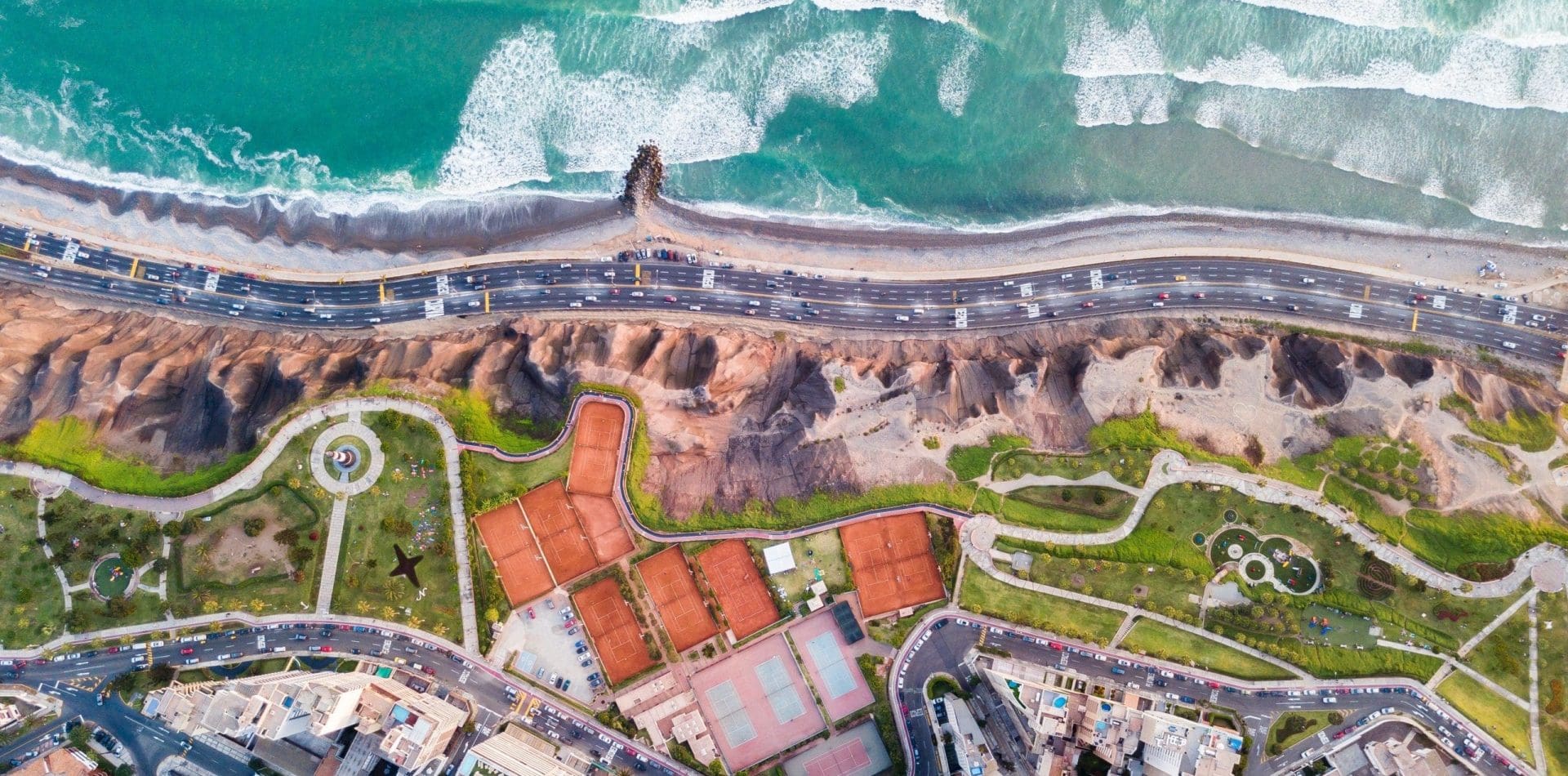Lima off the beaten path - an insider's guide
Table of Contents
Plaza Mayor, the Basilica of San Francisco and the Catacombs, Miraflores Ocean Boardwalk, Huaca Pucllana and Barranco’s gastro scene – So you’ve visited all of Lima’s highlights and main attractions while indulging in the city’s incredible culinary delights? Great, let’s see what else is there.
A lot of travellers see Lima just as a means to an end to get to Cuzco and Machu Picchu, which is a real shame. If you’re not in a rush, exploring Lima off the beaten path will give you an authentic insight into the lives of the locals and why Lima is becoming a favourite for digital nomads in South America. Granted, it hasn’t reached the Latin American digital nomad heights of Medellin or Mexico City yet, but it’s on the way.

I’m probably quite prejudiced. Having spent six months in Lima years ago studying abroad during my Master’s program, I have since been an avid supporter of Peru’s capital. Once you delve a bit deeper, Lima is such fun city to stay in. So for all slow travellers, digital nomads, off the beaten trackers and everyone in between, here are the things to do in Lima off the beaten path including day trips from Lima.
Circuito de Playas - Costa Verde
The Circuito de Playas also known as Costa Verde is a 25km long coastal stretch connecting Lima’s suburbs from San Miguel to Chorillos along coast. With the increase in culinary related travel to the world’s top foodie destination, Lima’s government has invested heavily in the touristic infrastructure over the past decade. The Circuito de Playas is now well maintained, safe and offers cyclers, runners, surfers and everyone else spectacular views, beaches and activities along the way.


Highlight
Caral Ruins
The Caral Ruins, about 3 hours north of Lima in the desert, are the oldest ruins of the oldest civilisation in South America. The site dates back 5000 years to the pre-Columbian Norte Chico civilisation and thus predating the Incas by about 4000 years. In fact Caral is considered the second oldest surviving city in the world. So I’d almost say it’s a must-do day trip when in Lima. This once bustling metropole is an architectural masterpiece with pyramids, houses, temples and amphitheatres stretched out over 160 acres.
While it’s impressive either way, I recommend getting a guide who can explain the structures and artefacts that have been found over the years. When I visited Caral in 2011, the site was still officially off limits for tourists. Walking around the site knowing how long it’s been here through the millennia, long before the foundation was set for The Great Pyramid of Giza, was simply magical. Since 2013 the site is open to the public, however has luckily been spared the pre-Covid mass tourism you find elsewhere in Peru. Caral is still a hidden gem and a true Lima off the beaten path destination.
The Caral Ruins date back around 5000 years to the pre-Columbian Norte Chico civilisation and is the oldest preserved ancient city in the Americas and is among the most ancient surviving urban structures.

How to get to the Caral Ruins from Lima
If you decide to visit the Caral ruins independently, you can take any bus heading north on the Pan-American highway. Check the bus companies Turismo Barranca or Turismo Paramonga. Both have their offices in La Victoria. Tell the driver to drop you off in the village of Supe. From here you can take a colectico or taxi close to the site. When you tell the driver where you’re headed they know where to drop you off (El Puente). From here it’s a 15min walk to the ruins. Make sure you’re back at the drop-off spot before 4pm – you don’t want to be stuck in the desert for the night.
Fishing Culture Tour

This tour offered by the sustainable tour company Alternative Peru gives you an insight and taste of Lima’s local fishing culture. You’ll visit a local off the beaten path fish market, go a boat tour with a local fisherman, visit an artisanal boat maker’s workshop and have (the best!) ceviche at a local family’s house. Alternative Peru solely works with local communities in and outside of Lima and offers a range of tours that all aim to have a social impact on marginalised groups.

Callao District Graffiti
Only 10 years ago the district of Callao was a no-go zone but has since gone from a crime-ridden area to a colourful artistic neighbourhood. Callao undoubtedly features Lima’s best street art with about 600 murals of national and international graffiti artists. It’s one of Lima’s best kept secrets.
Once again I highly recommend booking a tour with Alternative Peru. Besides exploring Callao’s graffiti, you’ll learn about the district’s history and transformation, have lunch at a local family’s house and get top have a go at some murals and learn the basics from a local street artist.

If there was a definition of “off the beaten track”, then Camino Copalita would be it. Once on the trek, there is no easy access in or out – no major roads and no cities nearby. There is no signal along the route either, although all guides carry satellite phones in case of emergencies.
Lunahuaná - Cañete River
Moving to Lima in 2011, Lunahuaná and the Cañete River was the first Lima day trip I went on. Lima is busy, loud and polluted, so it’s good to get out for a bit. While Lunahuaná is only a 3 hour journey from the capital, it’s worth staying overnight. The region offers great hiking, cycling and white water rafting.

Where to stay in Lunahuaná
 There is an abundance of of welcoming guesthouses and beautifully located lodges for all budgets. The super comfortable cabins at El Molino Hotel sit right by the river and the restaurant prepares delicious local dishes. With $100 USD per night it’s more on the expensive site, but worth the great night’s sleep you’ll have there! Just outside of town, the Confianza Hotel offers comfortable wooden bungalows, exceptionally beautiful gardens and good food for about $75 a night.
There is an abundance of of welcoming guesthouses and beautifully located lodges for all budgets. The super comfortable cabins at El Molino Hotel sit right by the river and the restaurant prepares delicious local dishes. With $100 USD per night it’s more on the expensive site, but worth the great night’s sleep you’ll have there! Just outside of town, the Confianza Hotel offers comfortable wooden bungalows, exceptionally beautiful gardens and good food for about $75 a night.


Archaeological site of Pachacamac
If you don’t have time to go all the way to the Caral Ruins, then the archaeological site of Pachacamac might be a good alternative. The area features dozens of ruins and temples, 45min outside of Lima to the south. The name of Pachacamac is related to the pre-Incan god of Pacha Kamaq and translates to Creator of the World in Quechua. The site dates back to 200 AD and flourished for about 1300 years before the Spanish arrived. Pachacamac is situated on a desert plateau with amazing views over the coast and the Pacific.

Mercado de Brujas
Known as the witches market, Mercado de Brujas is entertaining, educative and scary at the same time. You’ll find all sorts of weird and interesting items for ceremonies and rituals as well as traditional plant medicine. I found it incredibly interesting to see how different traditions, belief systems and religions are intertwined. More than 90% of Peruvians identify as Christian (mainly Catholic), yet their religious practices have a high degree of syncretism with indigenous traditions and rituals. The market is definitely worth a visit, just don’t get freaked out!

Lima really is so much more than a quick stopover. I mean the culinary scene alone is worth staying weeks or longer. But besides being a foodie heaven, as with so many cities, you’ll only “get” Lima when deciding to stay for a while. Peru specialists, let me know in the comments what you would add to this Lima off the beaten path list, I’m sure there are other hidden gems worth checking out!









